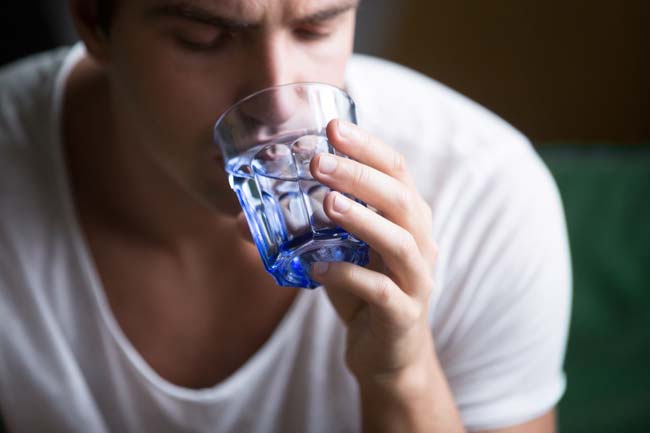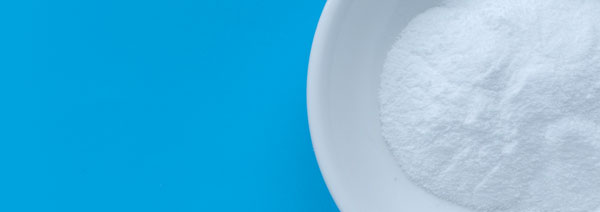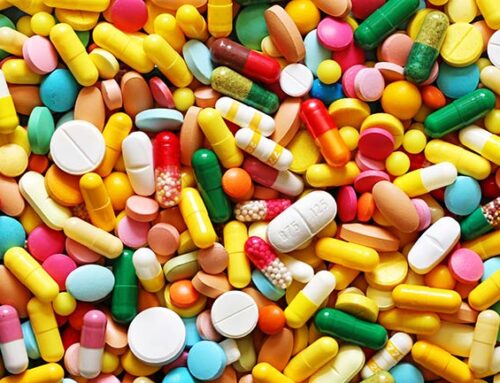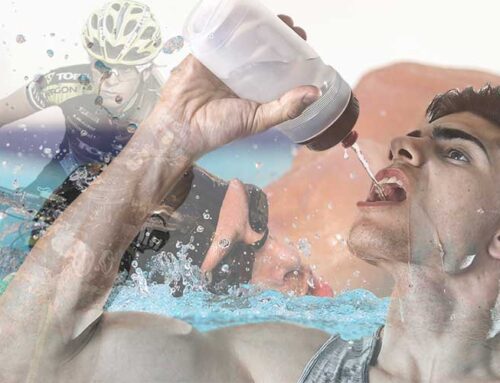Staying hydrated is important, but can you drink too much water? If you are an endurance athlete you may have experienced feeling bloated or like the water you are drinking is no longer working. In this article, we explain the science behind why over hydration can occur when electrolytes become so diluted that the kidneys stop functioning. There are several words people use for this physical state: hyponatremia, water intoxication, water toxicity, or plain old over hydration. It is important to note that it isn’t a function of too much water, but is caused by electrolyte depletion. In summary, it is a combination of electrolyte loss with too much water which throws the body out of balance. In rare cases, it can cause death.
Hyponatremia—What is it?
Hyponatremia is a low concentration of sodium in the blood often due to drinking too much water. This means that over hydration is actually more of an electrolyte imbalance than anything.[1] In spite of the abundance of negative press that salt has received, sodium and chloride (NaCl) are both essential minerals and the body is in big trouble if there is not enough.
In healthy people, blood sodium ranges from 137-147 mEq/L. But in people with hyponatremia, sodium levels fall below 137 mEq/L.2 Hyponatremia has killed seemingly healthy individuals every year, and in less severe cases it can significantly impede performance
How common is hyponatremia?
An article published in Runner’s World states the following:
Results have shown anywhere from .1 percent of endurance athletes to 50 percent (in a 100-miler) are hyponatremic at the finish. The most famous study, involving the 2002 Boston Marathon, found an incidence of 13 percent. Many runners, including me, were stunned by the reports of gross overdrinking.

Symptoms of drinking too much water
Common symptoms include:
- Weakness
- Agitation
- Confusion
- Nausea, or vomiting
It is common sense that if you are exercising and your rings get tight, your stomach sloshes, and you feel nauseated you should stop and do something about it.
Dr. Dana Cohen, the author of the book Quench, outlines the effects of too much or too little hydration:
The effects of chronic low-grade dehydration are real, long lasting, and potentially very debilitating. We believe this hypo- hydration is the mother of all epidemics and can be linked to many common ailments. The cues are afternoon fatigue, a decline in cognitive performance, headaches, weakness, urinary tract infections, and constipation. But some other disorders resulting from dehydration may come as a surprise: sleeplessness, decreased immunity, joint pain, chronic diseases like fibromyalgia, type 2 diabetes, reflux, and even Alzheimer’s. Suffice it to say that dehydration can have a big— and lasting—effect on our overall health…(but)…Drinking too much water can flush out vital nutrients and electrolytes from your cells and tissues, actually harming your health and limiting your body’s ability to perform.
Who is at risk for drinking too much water?
Hyponatremia may occur when someone has been drinking a lot of water during exercise, and electrolyte levels are already low because of sweat. What happens is that all that water further dilutes the electrolytes. This condition most often strikes in marathoners or triathletes during long or ultra-distance races in the heat. However, it can happen any time during extended periods of physical activity when an athlete consumes too much fluid and not enough electrolytes. For example, during a Hawaiian Ironman Triathlon, hyponatremia occurred in nearly 30 percent of the triathletes.[3]
Related article: Many medications can induce electrolyte deficiency
The two primary risk factors for an athlete developing hyponatremia are:
- Excessive fluid consumption, and
- Longer finishing times [4]
Hyponatremia also occurs in patients with underlying conditions, such as the elderly. An article in the Clinical Journal by and notes the following:
The management of hyponatremia is still suboptimal. This is worrisome not only because hyponatremia counts as the most common electrolyte disorder in hospitalized patients but also because it is associated with increased mortality.
That article goes on to state additional risks of hyponatremia. “For example, emerging data implicate hyponatremia in falls, osteoporosis, and fractures, suggesting an effect on the nervous system and bone. Little is known about the effects of hyponatremia on other organs, such as the heart, although a recent study identified hyponatremia as an independent predictor of myocardial infarction in community patients.”
Should you take your exercise with a grain of salt?
Often, salt tablets and sodium-enhanced beverages are promoted as an ideal way to replenish the salt that is lost through sweat. This is because sodium (Na) is the predominant electrolyte found in extracellular fluid. It is important in maintaining the proper acid-base balance and in the transmission of nerve impulses.[5]
Related article: Saltwater hydration – The surprising science of electrolytes and dehydration
Why salt tablets for hyponatremia are not enough
Many athletes and others exposed to heat stress consume salt supplements, but there are additional electrolytes lost in sweat. It has been shown in at least one study that supplementation with salt tablets, i.e., sodium chloride alone, is insufficient.[8]
This is because additional electrolytes are lost in sweat. A normal water and electrolyte balance must include magnesium, potassium, and chloride, and deficiencies in these can cause problems such as nausea, vomiting, and muscle cramps.
For example, sodium teams with potassium to maintain proper body fluid, acid-base balance, and blood pressure. Potassium and other electro lytes—such as magnesium and chloride—work in concert with sodium to conduct nerve impulses, promote normal muscle contraction (including the heartbeat), regulate the transfer of nutrients to cells; and maintain the normal function of the kidneys, heart, and nerve cells. Magnesium is also important for lung health. An imbalance of any electrolyte can have far-reaching, serious effects within the body.[5]
In addition, taking salt tablets during high-endurance activities can cause unpleasant and sometimes debilitating side effects. Concentrated salt tablets may actually encourage dehydration by lowering the level of water in the blood. This is because salt tablets can cause water to be pulled from surrounding body tissues where it is needed during high-endurance activity. This water goes into the stomach in order to dilute the salt. For the athlete, the result can be stomach cramps, nausea, or worse, vomiting.
Supplementing with sodium alone can also negatively affect potassium and magnesium levels, which, consequently, could reduce performance and contribute to muscle cramping or a charley horse.
Data about the loss of other electrolytes
One year in the Houston Marathon, there were 21 hyponatremic runners who sought aid. Their electrolyte levels were tested, which revealed not only low sodium but also lower potassium and chloride levels than those runners who did not have water toxicity intoxication. [4]
The Hawaiian Ironman study reported a 30 percent incidence of hyponatremia among athletes, but a lesser-known fact was that researchers also discovered that 20 percent had hypomagnesemia (low serum magnesium).[3]
One study found a 12 percent decrease in muscle magnesium that correlated with 5.8 percent dehydration while muscle sodium and chloride levels remained unchanged.[6] One of the primary functions of magnesium is that it activates ATP (adenosine triphosphate), which is the energy-carrying molecule the body uses for all forms of energy. This means that magnesium in the muscle could interfere with energy conversation and fatigue. Low magnesium levels are also associated with both spasms and cramping.[7]
What are the best recommendations?
The American College of Sports Medicine (ACSM) recommends that individuals consume 500 ml (~ 17 oz.) of fluid two hours before exercise and that they continue to consume cool drinks in regular intervals to replace water lost through sweating or the maximum amount that can be tolerated. ACSM also recommends adding electrolytes to fluid for prolonged intense exercise lasting longer than one hour.[9-10]
The best way to replace fluids and the balance of electrolytes lost through sweat is to drink water fortified with a balanced electrolyte Supplement. The best way to prevent an electrolyte or fluid imbalance is to consume fluid and electrolytes in proper balance with each other. In other words, you can drink too much water and have negative effects without the proper electrolyte supplementation.
Related article: Natural electrolytes are essential for life, health, and peak performance
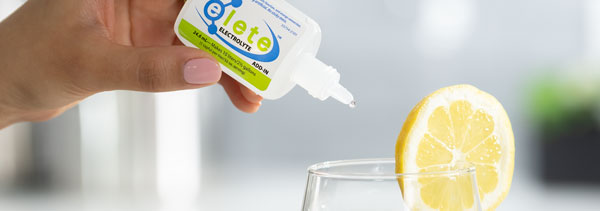
Water and electrolytes, a winning combination
In a study of elete Electrolyte Add-in (a balanced electrolyte) conducted through the University of Montana’s Human Performance Laboratory to determine the effects of water alone compared with water and elete electrolyte, this replacement was used under the most severe environmental, physiological, and psychological endurance conditions possible—wildland fire suppression.[11] Wildland firefighters work very long shifts (just under 15 hours in the elete study) in the most extreme of conditions. Often, the total body energy expenditure of a firefighter can increase 3.6 times the basal metabolic rate. Due to the highly physical nature of the job, the hydration demand is significant; however, immediate water availability can be problematic due to the logistics associated with transporting water. In addition to extreme temperatures and physical work involved with fire suppression, the demands of the job, itself, are constant and unending—a typical assignment may last up to a week or more.
The ELETE study revealed the effectiveness of adding elete to normal drinking water under arduous working conditions.
Two specific study details include the following: [11]
- Firefighters who consumed water alone had to consume significantly higher amounts of water (74 percent more) in order to achieve the same level of hydration as the elete group.
- The total water intake was 3.2 liters less per person over a day for the elete group.
In other words, the water-only group had to consume dramatically more water to maintain whole-body hydration and body weight. The takeaway is that when people are in an endurance sport or intense heat-stress situation s, the key to optimal performance is to maintain adequate hydration so as to support the body’s cooling system and not lower electrolyte levels. If those levels become dangerously low, it can impair athletes’ and first responders’ performances.
By consuming elete with water during an event or when exposed to heat stress, the individual is metering the consumption of electrolytes with fluids, which reduces the rate of electrolyte depletion and enhances hydration. In the elete clinical study, it was shown that those who consumed water alone had to consume 74 percent more water than those who drank water with elete in order to achieve the same level of hydration. This benefit is compounded when attempting to prevent hyponatremia because athletes can achieve the same level of hydration with significantly fewer fluids thus reducing dilution of electrolytes.
Wrap up: Is drinking too much water bad?
Most people are more likely to experience dehydration than water toxicity, but of the two, hyponatremia is much more serious and can cause death. In summary, yes, drinking too much water is bad…when there is not a proper electrolyte balance. This condition is entirely preventable.
1. Hiller WD. Dehydration and hyponatremia during triathlons. Med Sci Sports Exerc. 1989 Oct; 21(5 Suppl): S219-21.
2. Horne MM and Swearingen PL. Fluids, Electrolytes, and Acid-Base Balance, MosbyYear Book, Inc., St. Louis, MO, 1993, 89.
3. O’Toole Ml, Douglas PS, Laird RH, Hiller DB. Fluid and electrolyte status in athletes receiving medical care at an ultradistance triathlon. Clin J Sport Med. 1995; 5(2):116-22.
4. Hew TD, Chorley JN, Cianca JC, Divine JG. The incidence, risk factors, and clinical manifestations of hyponatremia in marathon runners. Clin J Sport Med. 2003 Jan; 13(1):41-7.
5. National Research Council, Recommended Dietary Allowances, National Academy Press, Washington, D.C., 1989.
6. Costill DL, Cote R, Fink W. Muscle water and electrolytes following varied levels of dehydration in man. J Appl Physiol. 1976 Jan; 40(1):6-11.
7. Brilla LR and Lombardi VP. Magnesium in exercise and sport, in Macroelements, Water, and Electrolytes, Driskell, J.A., and Wolinsky I., Eds. CRC Press, Boca Raton, FL, 1999, chap.4.
8. Speedy DB, Thompson JM, Rodgers I, Collins M, Sharwood K, Noakes TD. Oral salt supplementation during ultradistance exercise. Clin J Sport Med. 2002 Sep; 12(5):279-84.
9. Convertino VA, Armstrong LE, Coyle EF, Mack GW, Sawka MN, Senay LC Jr., Sherman WM. American College of Sports Medicine position stand. Exercise and fluid replacement. Med Sci Sports Exerc. 1996 Jan; 28(1): I-vii).
10. Von Duvillard SP, Braun WA, Markofski M, Beneke R, Leithauser R. Fluids and hydration in prolonged endurance performance. Nutrition. 2004 Jul-Aug; 20(7-8):651-6.
11. Ruby, BC. “Effects of water and water + electrolytes on changes in body temperature, hydration status and drinking behaviors during arduous wildfire suppression.” Mineral Resources International, Ogden, UT, 2004.

